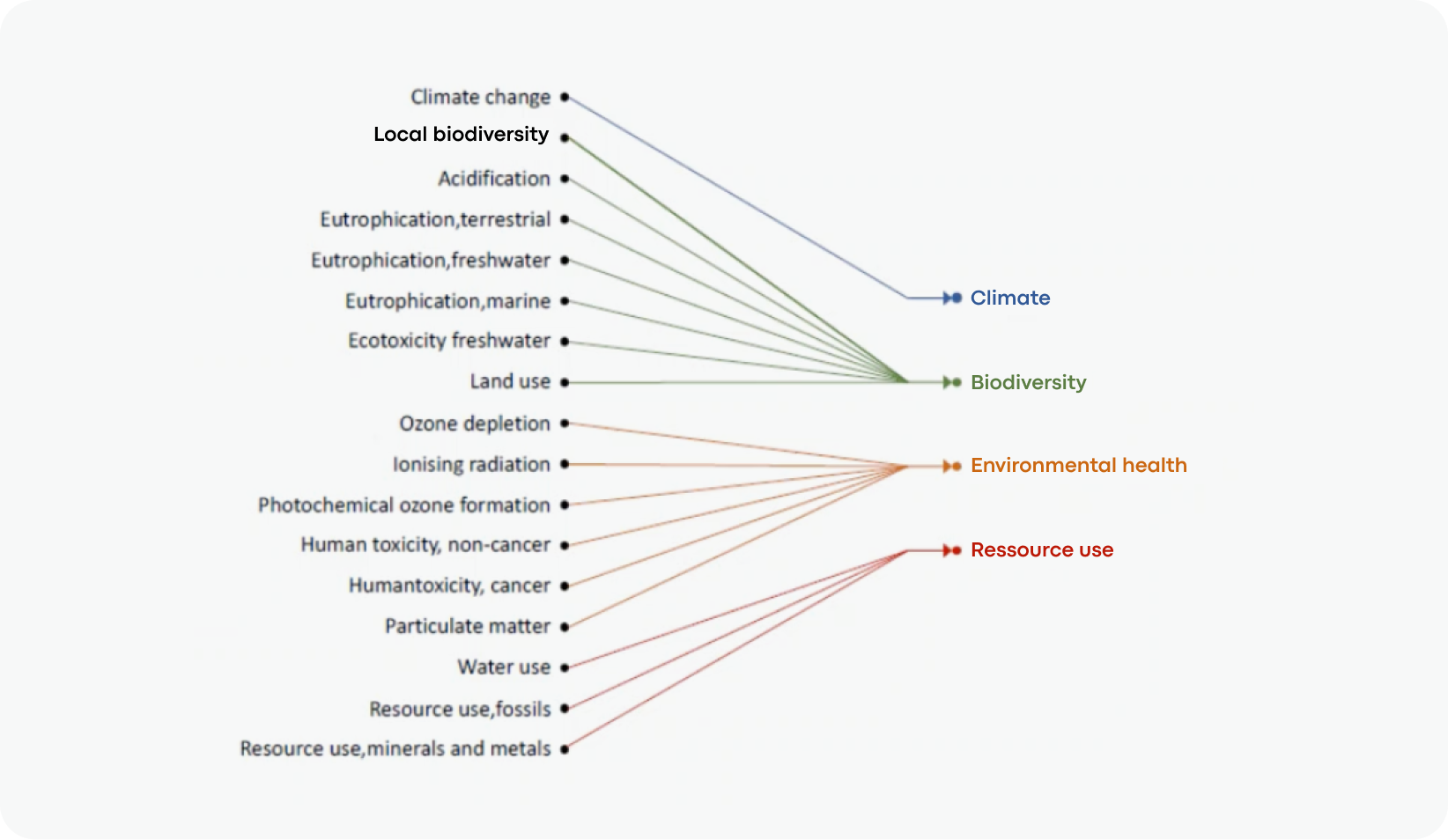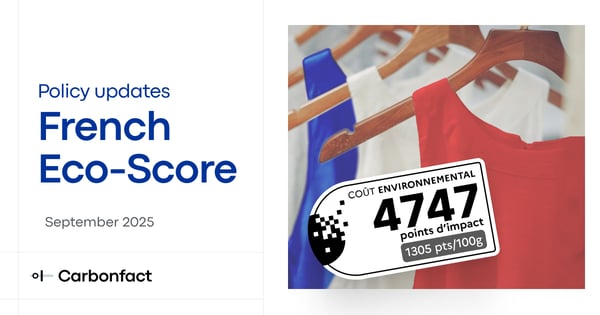What are the different standards for an LCA?
Over the last 40 years, LCA methodologies and standards have evolved and become more refined. Organizations and initiatives, such as the International Organization for Standardization (ISO) and the United Nations Environment Programme (UNEP), have played a significant role in developing internationally recognized LCA standards and guidelines.
ISO 14040 and ISO 14044: These international standards developed by the ISO provide a general framework for conducting and reporting LCA studies. They are applicable to all industries, including textiles.
ISO 14067: This standard focuses on the carbon footprint of products. It provides specific requirements and guidance for the quantification and communication of the carbon footprint of a product, based on its life cycle.
Product Environmental Footprint (PEF): Developed by the European Commission,PEF is a multi-criteria measure of the environmental performance of a product throughout its life cycle. It uses 16 different impact categories, including climate change, ozone depletion, and resource depletion, among others.
What’s the objective of an LCA in textile and fashion?
Life Cycle Assessment (LCA) for textile products aims to quantify and reduce the environmental impact of a product throughout its entire life cycle. It offers insights into where the highest environmental burdens occur, also known as 'hotspots,' informing decision-making towards more sustainable practices in areas like material sourcing, manufacturing, and product design. LCA validates 'green' claims, ensuring transparency and credibility, while aiding compliance with tightening environmental regulations. Lastly, it supports the shift towards a circular economy in the fashion industry, promoting strategies for longevity, recycling, and resource reutilization.
Setting boundaries during the LCA process
Conducting an LCA demands a clear definition of system boundaries, which mark the extent of the processes, activities, and impacts included in the study. In this industry, the boundaries can span from the sourcing of raw materials to the disposal of the final product.
Two prominent LCA boundary models for fashion and textiles are 'Cradle-to-Grave' and 'Cradle-to-Gate'.
- Cradle-to-Grave: This comprehensive model assesses impacts from the beginning (raw material extraction or 'cradle') to the end (disposal or 'grave') of a fashion product’s life cycle. It includes all stages, such as production, distribution, usage, and end-of-life management, along with the impacts of transportation between each stage. This model is particularly useful when you aim for a complete understanding of your product's environmental footprint, either for internal evaluation or for transparent communication to consumers.
- Cradle-to-Gate: This model covers the impacts from raw material extraction to the point when the fashion product leaves the factory gate, excluding the usage and end-of-life stages. It's often employed for industry comparisons or for Environmental Product Declarations (EPDs), as it concentrates on the processes under the direct control of manufacturers and suppliers.
The choice between these models depends on the goals of your LCA:
- Cradle-to-Grave: Select this model for a holistic view of environmental impacts, when developing sustainability strategies, making product development decisions, or communicating the total environmental footprint to stakeholders.
- Cradle-to-Gate: Choose this model when the focus is on improving manufacturing processes, comparing similar products at the point of manufacture, or when data on product usage or end-of-life stages is unavailable or uncertain.
Remember, the choice of boundary significantly influences LCA results. Hence, it's vital to clearly state the system boundary in your LCA report to ensure transparency and enable fair comparisons. By selecting the right boundary, your LCA will effectively serve its purpose, whether that's comparing products, reducing impacts, or informing consumers.
What environmental indicators should you look into?
When conducting an LCA in the fashion and textile industry, it is crucial to consider a wide range of environmental indicators to gain a comprehensive understanding of the product's overall environmental impact. These indicators represent different potential environmental impacts throughout the product's life cycle, for example global warming , acidification, eutrophication, ozone depletion, harm to ecosystems and humans, land use, water consumption, and more.
The Product Environmental Footprint (PEF) methodology, uses these and other indicators to provide a multi-criteria measure of the environmental performance of a product throughout its life cycle.
 The 16 environmental indicators that are considered in the PEF standard
The 16 environmental indicators that are considered in the PEF standard
By looking at these different indicators, we can get a more holistic view of the environmental impact of a product, avoiding "Carbon Tunnel Vision" (read this article to learn how the different environmental indicators correlate with each other).
Why is conducting a life cycle assessment important? What are the benefits?
As the textile sector grapples with an increasing demand for sustainable practices and transparency, an LCA provides scientific data that can be used to evaluate, improve, and communicate the environmental footprint of products. Here are some key reasons why LCAs are vital in this industry:
Reporting and Compliance: Regulatory bodies, especially in regions like the EU, are increasingly demanding companies to disclose their environmental impacts. For example, France recently introduced a law requiring brands to label the environmental impact of their products. LCA provides the necessary data to comply with such regulations.
Product Development: An LCA can inform sustainable product development by comparing the footprints of different materials and processes. This data can guide designers and product development teams towards choosing lower-impact alternatives. (See case study)
Supply Chain Management: LCAs can illuminate the environmental impact at different stages of the supply chain. By quantifying environmental KPIs, companies can make more informed decisions about sourcing and managing suppliers.
Marketing and Communication: LCA data allows marketing teams to communicate the environmental impact of products accurately. This scientific backing enhances credibility and allows brands to meet the growing consumer demand for transparency and sustainability.
Strategic Planning: Conducting an LCA can help identify environmental hotspots within a company's operations. This data can inform overarching strategies and guide businesses towards more sustainable practices, including product redesign, supply chain optimization, or new eco-friendly initiatives.
Example: Conducting an LCA for a T-shirt
Let’s imagine for a second that we want to calculate the environmental impact of a T- shirt.
Typically, the life-cycle of T-shirt consists of the following stages:
- Raw material extraction: The first phase involves getting the materials to make the T-shirt. Cotton is commonly used, so this phase includes growing cotton plants and harvesting the cotton fibers. The amount of water, fuel, and land used at this stage are assessed in the LCA.
- Manufacturing and assembly: In this phase, the extracted materials are processed and transformed into fabric. The cotton fibers are spun into yarn, which is then woven or knitted to create the fabric for the t-shirt. The fabric is cut and stitched together to make the T-shirt shape. The amount of electricity and heat used by machines as well as chemical materials are important parameters.
- Transportation and distribution: Once the T-shirts are manufactured, they need to be transported to their destination. This phase involves shipping the T-shirts from factories to distribution centres, and then to retail stores or directly to customers. Transportation methods such as trucks, ships, or airplanes are often used to transport the T-shirts.
- Use and maintenance: This phase begins when the consumer purchases and starts wearing the T-shirts. This includes activities such as washing, drying, and ironing. The energy, detergents and water used in maintaining and caring for the T-shirt during its use contribute to its overall environmental impact.
- End-of-life: Eventually, the T-shirt reaches the end of its life-cycle. This phase looks at how the T-shirt is disposed of, or managed after use. Usually T-shirts are either recycled, where the fabric is turned into new materials, or disposed of in landfills and/or incinerated.
During these phases, various environmental impacts can arise, including the widely recognized Global Warming Potential, commonly known as carbon footprint, as well as energy consumption, toxicity impact, water usage, and waste generation. The objective of conducting an LCA is to evaluate and understand these impacts, and identify areas for improvement to pave the way for more sustainable practices.
What are the challenges of LCA in the fashion industry?
Conducting an LCA can be a challenging endeavor for many brands. Here are some of the key difficulties they encounter:
Cost and Expertise: Conducting an LCA can be a costly process that involves purchasing licenses for specialized software, such as Gabi or Simapro, and acquiring access to extensive databases like Ecoinvent. Additionally, the process is often complex, requiring a significant investment in terms of time and specialist knowledge to carry out effectively. As a result, many brands hire consultants to manage their LCA studies, further escalating the cost.
Data Collection: Gathering accurate and comprehensive data for an LCA can be a challenging task in the textile industry. Transparency issues can arise, as suppliers may not be forthcoming with necessary information about their processes. Tracking specific impacts, such as water and energy usage, chemical releases, or waste production, can be especially difficult.
Supply Chain Complexity: Textile industry supply chains are typically complicated, encompassing a multitude of stages, stakeholders, and geographical locations. Assessing the environmental impacts at each stage, from raw material sourcing to manufacturing, transport, use, and end-of-life, requires extensive cooperation with various parties and an in-depth understanding of each process.
Fast-Changing Trends: The dynamic nature of the fashion industry presents an additional challenge. As trends shift rapidly, so do the materials, designs, and production methods, each carrying their own unique environmental impacts. Keeping up-to-date with these constant changes and incorporating them into ongoing LCA studies can be both time-consuming and costly.
What tools are used to conduct an LCA?
There are many solutions to assist brands to overcome these challenges.
Traditional software tools used for LCA studies include OpenLCA, Gabi, and Simapro. These systems are capable of performing complex LCA calculations but often require a considerable investment of both time and money. Typically, consultants are hired to gather and input the necessary data and to navigate the complexities of these tools.
However, the emergence of new tools is revolutionizing the LCA landscape. One such example is Carbonfact, a carbon management tool, a tool tailored to the fashion industry's unique needs. Unlike traditional LCA tools, Carbonfact is designed to perform real-time LCAs by connecting to your existing data systems, such as Enterprise Resource Planning (ERP) and Product Lifecycle Management (PLM) systems. This means that LCAs can be updated dynamically whenever new primary data is available, offering a forward-looking, agile approach to environmental impact assessment.
How does Carbonfact conduct Product LCAs?
Carbonfact has developed a unique and innovative approach to conduct product LCAs for fashion and textile companies, aiming to mitigate many of the challenges traditionally associated with this process. Here's how the process works:
Automation: Carbonfact automates both the data collection and impact assessment process of the LCA. Through automation, we can quickly and accurately assess the environmental footprint of your entire product catalog. Instead of manually gathering and analyzing data for each individual product, the process can be completed in just a few weeks, significantly reducing the time and cost typically associated with LCAs.
Smart Filling: Recognizing that primary data gaps can occur, Carbonfact uses established third-party databases and academic studies, such as Ecoinvent, Base Empriente, EF 3.1, and the Mistra Future Fashion study, to fill in any missing data. Furthermore, we apply machine learning techniques to handle any missing data points. For example, the product's weight can be estimated based on its composition, allowing for the estimation of product footprints even if not all data points are available.
Streamlined Data Collection: By identifying the most significant environmental impact areas or "hotspots" from the LCA results, Carbonfact helps you focus your data collection efforts on the most relevant suppliers. This targeted approach can save time and resources and can lead to more impactful environmental improvements.
Real-Time LCA: Carbonfact's platform is designed to be dynamic and responsive. When new data points are collected, the LCA results are automatically updated through integrations with your existing Enterprise Resource Planning (ERP) and Product Lifecycle Management (PLM) systems. This real-time updating allows for an ongoing and timely understanding of your product-level and company-level environmental footprint, which is needed in the fast-paced world of fashion, where trends can rapidly change the sustainability profile of your products.
By leveraging technology and smart data management, Carbonfact has transformed the way LCAs are conducted in the fashion industry, making them more accessible, efficient, and effective in driving sustainability efforts.
Further reading LCA in fashion and LCA studies:
If you're interested in learning more about Life Cycle Assessment (LCA) in the fashion industry and looking to delve deeper into the subject, I would recommend the following resources:
Mistra Future Fashion report: A research program with a vision for a systemic change in the Swedish fashion industry leading to sustainable development of the industry and wider society.
Product Environmental Footprint Category Rules (PEFCR) - Apparel and Footwear: The European Commission's draft for the PEFCR is intended to serve as a guideline for measuring and communicating the environmental performance of apparel and footwear.
Ellen MacArthur Foundation - Life Cycle Assessment for the Circular Economy: The Ellen MacArthur Foundation provides resources on circular economy, including the role of LCA in achieving circularity. You can learn how LCA can help identify opportunities for reducing environmental impacts and enhancing circularity.
Textile Exchange LCA FAQ: Textile Exchange provides answers to frequently asked questions about LCAs in the textile industry. It's a great resource if you're new to the concept and looking for a concise introduction to the subject.
Want to run an LCA for all of your products at the fraction of cost and time of traditional methods? Book a demo with our team to find out more.
Watch a Carbonfact demo









 Martin Daniel
Martin Daniel

 Lidia Lüttin
Lidia Lüttin
